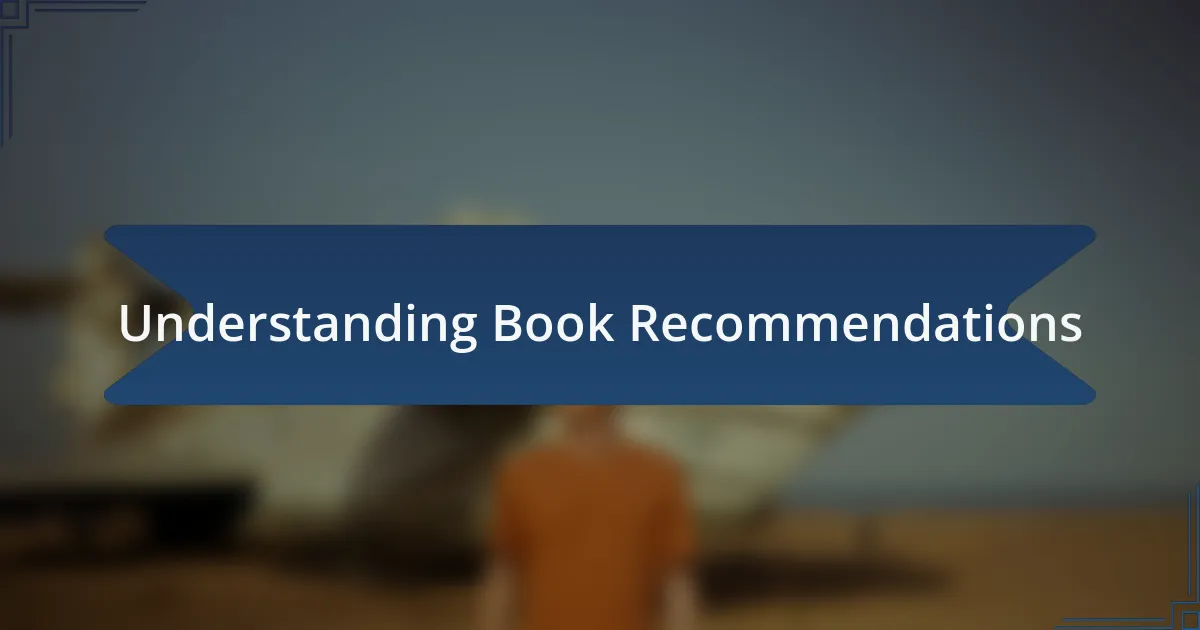Key takeaways:
- The emotional connection to stories greatly influences book recommendations, making them more meaningful to both the giver and receiver.
- Agatha Christie, known as the “Queen of Crime,” has profoundly shaped the mystery genre with her intricate plots and memorable characters, inspiring readers and authors alike.
- Key elements of Christie’s writing include meticulous crafting of suspense, compelling characterization, and clever plot twists that engage readers on multiple levels.
- Sharing book recommendations becomes richer when personal stories, visuals, and engaging discussions about books are included, enhancing the experience for both parties.

Understanding Book Recommendations
When it comes to book recommendations, I often find myself considering the emotions tied to the stories. A friend once asked me for a mystery novel that could keep her on the edge of her seat; I recommended Agatha Christie’s “And Then There Were None.” I recalled how it had me turning pages late into the night, caught up in suspense. This personal connection to different books is what truly shapes my recommendations.
I’ve learned that understanding the reader’s personal preferences is essential. Do they prefer a classic whodunit or something with a modern twist? Last year, I suggested “Murder on the Orient Express” to someone who loves historical settings, and the joy in her face when she finished it was priceless. It’s these emotional responses that make recommendations more rewarding.
Rhetorically, I often ask myself: what resonates with the reader? I remember recommending “The ABC Murders” to a family member who needed a quick but gripping read. His appreciation for the clever plot twists deepened our discussions about Christie’s mastery, highlighting that the right book can lead to meaningful conversations and connections. Understanding what drives a reader’s interest allows me to make tailored recommendations that spark joy and engagement.

Importance of Agatha Christie
Agatha Christie is often hailed as the “Queen of Crime” for good reason. Her ability to construct intricate plots and develop unforgettable characters showcases her profound understanding of human nature. I vividly remember my first encounter with “The Murder of Roger Ackroyd”; I was completely taken aback by the twist at the end. This experience opened my eyes to how a well-crafted mystery can challenge our perceptions and keep us guessing.
Moreover, Christie’s works have left an indelible mark on the mystery genre, influencing countless authors who followed in her footsteps. I often reflect on how her storytelling techniques have shaped my reading preferences. When I introduced a colleague to her short stories, he remarked on how they revitalized his love for mysteries by highlighting the subtleties of character interaction. Isn’t it incredible how her work continues to inspire fresh perspectives even decades later?
Her themes often explore the darker side of human nature, inviting readers to delve into their fears and curiosities. I recall discussing “Death on the Nile” with a group of friends; we uncovered layers of motivation and betrayal, igniting a lively debate on trust and deception. This ability to spark conversation about complex themes is a testament to her significance in literature, making her work not just an escape, but a source of wisdom.

Key Elements of Christie’s Writing
Christie’s writing is meticulously crafted, often featuring closed-circle settings that heighten suspense. I distinctly remember reading “And Then There Were None” during a rainy afternoon. The isolation of the characters on that remote island made my heart race; the sense of entrapment she builds ensures that readers feel every ounce of tension. Isn’t it fascinating how an enclosed space can amplify the stakes in a story?
Characterization in Christie’s novels is another hallmark of her genius. For me, her protagonists, especially Hercule Poirot, are more than just detectives; they represent complex human qualities and flaws. I once debated with a friend about Poirot’s fastidiousness—does it make him a genius or merely pedantic? This kind of characterization invites us to reflect on our own habits and quirks, striking a personal chord that lingers long after the final page.
Plot twists are perhaps the most exhilarating element of Christie’s storytelling. When I first read “The Orient Express,” I was astounded by the numerous possibilities presented until the very end. That moment when everything clicks into place is like magic; it compels you to reconsider every detail you thought you understood. How does she do it? Her skillful misdirection and nuanced revelations keep the reader guessing, challenging us to become detectives in our own right.

Criteria for Selecting Recommendations
When I think about how to select book recommendations, I often consider the emotional impact of the story. For example, a book that made me feel an overwhelming sense of nostalgia or suspense is often a great candidate. Isn’t it true that the best stories are those that linger in your mind, prompting you to reflect long after you’ve turned the final page?
I also look for books that display a strong connection to Christie’s unique themes, like mystery or human psychology. Once, I stumbled upon a novel that mirrored the emotional complexity of “Murder on the Orient Express.” It made me think about how intertwined characters can create tension in ways that feel both thrilling and relatable. When seeking recommendations, I find that these deeper connections resonate with fellow fans.
Lastly, the writing style is crucial—does it transport you, or does it drag? I remember diving into a contemporary mystery that echoed Christie’s style but brought a fresh twist. If a recommendation can captivate my attention with an engaging narrative, it’s likely to resonate with others too. What about you? How much does style factor into your reading choices?

Personal Favorites from Christie
One of my all-time favorite Agatha Christie reads has to be “And Then There Were None.” The clever construction of suspense and the chilling atmosphere left a lasting impression on me. I remember feeling a mix of excitement and anxiety as the story unfolded, which made me ponder how isolation can magnify human fears and vulnerabilities.
Another standout for me is “The Murder of Roger Ackroyd.” The bold narrative twist caught me completely off guard. I still recall the surprise coursing through me, reminding me of the joy that comes with unexpected storytelling. Have you ever read a book and felt your perspective entirely shifted in an instant? That’s what Christie’s genius evokes.
I can’t overlook “Death on the Nile,” either. The dramatic setting and intricate relationships among characters added layers to an already captivating plot. Reflecting on my own travels, I felt as if I was transported back to those moments of discovery and intrigue, questioning the motives of everyone around me. Isn’t it fascinating how Christie weaves the backdrop into the narrative, creating a rich tapestry of experience?

How to Share Recommendations
When it comes to sharing book recommendations, I often find that personal touch makes all the difference. For instance, I like to explain what specifically drew me into the story or how it resonated with my life experiences. Have you ever noticed how a simple personal story can transform a recommendation from just a title to a shared experience?
I also believe visuals can enhance the sharing process. I’ve occasionally created mood boards or pinned quotes from the book that encapsulate its essence. This not only captures attention but can also evoke emotions that words alone might miss. What’s your go-to method for making a book recommendation stand out?
Engaging with others about recommendations can also be a delightful conversation starter. I often ask friends what they are currently reading or their favorite Christie novels, and it opens up a wonderfully rich dialogue. This back-and-forth allows me to suggest books that align with their tastes while also learning more about their preferences. Don’t you find that recommendations become more meaningful when they stem from genuine connection?

Engaging with Readers about Christie
I love diving into discussions about Agatha Christie with fellow enthusiasts. Recently, I found myself in a cozy café, chatting with a friend who had just finished “Murder on the Orient Express.” I had so much fun hearing their theories about the plot twists. Doesn’t it feel electric when someone shares the same passion for Christie’s intricate storytelling?
Understanding what intrigues my readers also means paying attention to their reactions. I recall a lively book club session where I suggested “And Then There Were None.” The way everyone lit up with different interpretations made me realize how varied personal connections to Christie’s work can be. Have you ever seen how a single book can spark debates that reveal different facets of human experience?
Moreover, I enjoy creating an immersive atmosphere around Christie discussions. I often set the scene with the right ambiance—perhaps some vintage music playing softly in the background—to enhance the experience. Have you ever noticed how much more enjoyable a conversation becomes when it’s wrapped in a complementary setting? It’s all about creating those memorable moments that deepen our appreciation for her work.